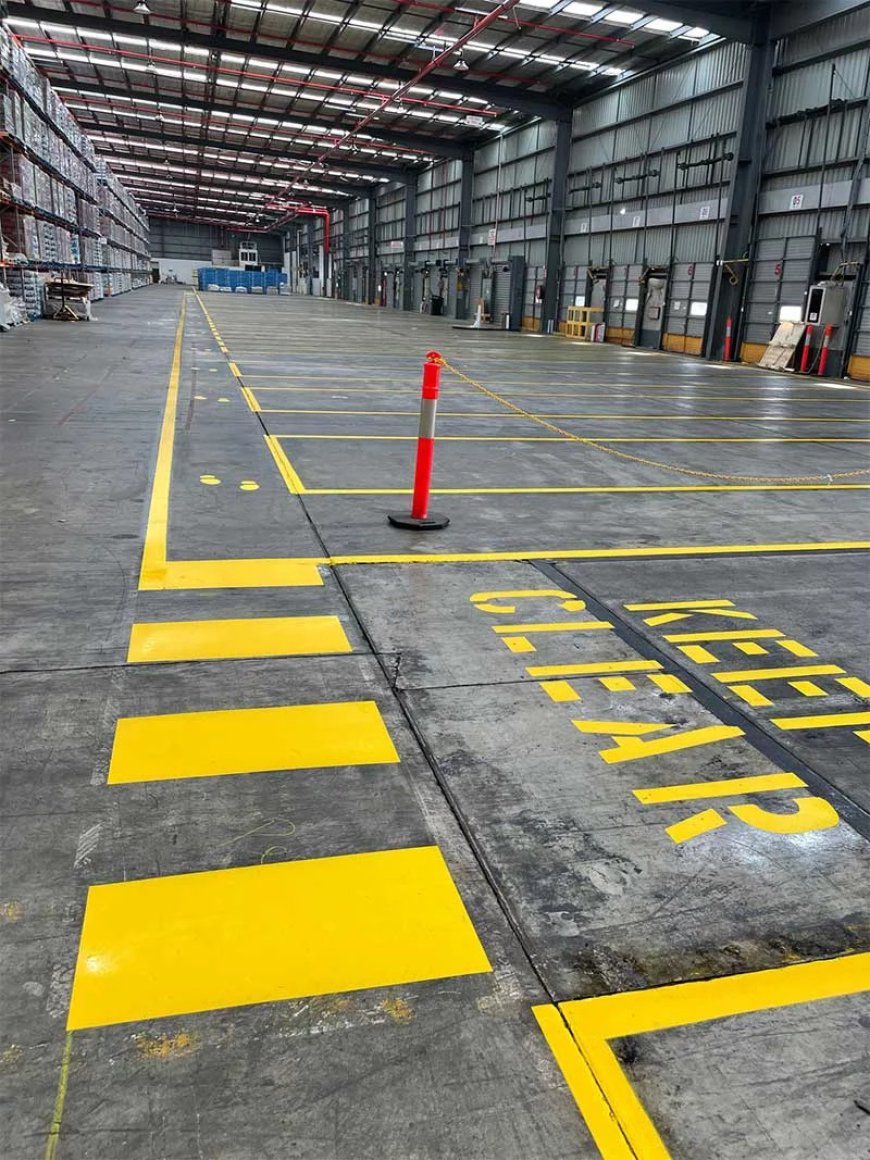How Floor Marking in Warehouses Improves Workflow?
Floor markings in warehouses enhance efficiency and safety by providing clear navigation, defined zones, and hazard identification. They streamline operations, improve inventory management, and assist in training new staff. Customisable and cost-effective, well-maintained floor markings increase productivity and reduce accidents, contributing to a safer, more organised work environment.

In the busy environment of a warehouse, the efficiency and safety of workers and cargo are paramount. With numerous activities occurring simultaneously—such as receiving, storing, and shipping goods—organising these processes is essential for maintaining productivity. One effective solution that can significantly enhance workflow in warehouses is the implementation of floor markings. In this article, we will explore how floor markings in warehouses improve workflow and contribute to a more safe and efficient working environment.
Clear Navigation and Layout
One of the primary benefits of floor markings is that they provide clear navigation throughout the warehouse. By designating specific areas for different activities, workers can easily understand where to go and what to do.
-
Defined Pathways: Floor markings create defined pathways for pedestrians and vehicles, reducing confusion and minimising the risk of accidents. This clarity allows workers to navigate the warehouse more efficiently.
-
Zoning: Specific zones can be marked for receiving, storage, packing, and shipping. This zoning helps employees quickly locate items and understand their responsibilities within each area.
Enhanced Safety Measures
Safety is a critical concern in any warehouse setting, especially with the presence of heavy machinery and high volumes of foot traffic. Effective floor markings can significantly enhance safety measures.
-
Hazard Identification: Brightly coloured markings can indicate hazardous areas, such as loading zones or areas where forklifts operate. This visual cue alerts workers to exercise caution when navigating these spaces.
-
Emergency Routes: Clearly marked emergency exits and evacuation routes ensure that employees know how to exit the building safely in case of an emergency.
Streamlined Operations
Floor markings contribute to streamlined operations by reducing the time spent searching for items or navigating the warehouse.
-
Efficient Picking Processes: When aisles and storage locations are clearly marked, warehouse staff can quickly identify where items are located, leading to faster picking times and improved order fulfilment rates.
-
Reduced Downtime: With clear pathways and designated zones, workers spend less time figuring out where to go or how to navigate the space, resulting in increased productivity.
Improved Inventory Management
Effective floor marking plays a crucial role in inventory management by ensuring that products are stored in designated areas.
-
Organised Storage: By marking specific locations for different products or categories, warehouses can maintain better organisation of their inventory. This makes it easier to track stock levels and reduces the chances of misplaced items.
-
Cycle Counting: Regular inventory checks become more manageable when items are stored in clearly marked locations. Employees can quickly identify which areas need to be counted or audited.
Training and Onboarding
New employees often face challenges when learning the layout of a warehouse. Floor markings can simplify this process significantly.
-
Visual Aids: Clear floor markings serve as visual aids for training new staff members. They can quickly learn about different zones and pathways without needing extensive guidance from experienced colleagues.
-
Consistency: Consistent use of floor markings across all areas of the warehouse ensures that all employees understand the layout, regardless of their experience level.
Cost-Effectiveness
Investing in floor markings can lead to long-term cost savings for warehouses by improving efficiency and reducing accidents.
-
Reduced Accidents: By enhancing safety through clear navigation and hazard identification, warehouses can minimise workplace accidents that may result in costly medical expenses or downtime.
-
Increased Productivity: The time saved through streamlined operations translates into higher productivity levels, ultimately leading to improved profit margins.
Customisation Options
Floor markings can be customised to suit the specific needs of each warehouse, ensuring that they align with operational requirements.
-
Tailored Designs: Different colours, symbols, and patterns can be used to convey specific messages or instructions relevant to your warehouse operations.
-
Durable Materials: High-quality materials ensure that floor markings withstand heavy foot traffic and machinery without fading or peeling over time.
Regular Maintenance
To ensure that floor markings remain effective over time, regular maintenance is essential.
-
Repainting and Refreshing: Over time, floor markings may fade due to wear and tear from heavy machinery or cleaning processes. Regularly scheduled maintenance ensures that these markings remain visible and effective.
-
Adaptation to Changes: As warehouse operations evolve—such as changes in layout or product lines—floor markings should be updated accordingly to reflect these changes.
In conclusion, implementing effective floor markings in warehouses significantly improves workflow by enhancing navigation, safety measures, operational efficiency, inventory management, training processes, cost-effectiveness, customisation options, and maintenance practices. By investing in high-quality floor marking solutions from trusted providers like Western Suburbs Line Marking, warehouses can create a safer and more productive environment for their employees while optimising their operations for success.

 wslinemarking
wslinemarking